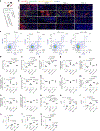Immunometabolic cues recompose and reprogram the microenvironment around implanted biomaterials
- PMID: 39367264
- PMCID: PMC12197073
- DOI: 10.1038/s41551-024-01260-0
Immunometabolic cues recompose and reprogram the microenvironment around implanted biomaterials
Abstract
Circulating monocytes infiltrate and coordinate immune responses in tissues surrounding implanted biomaterials and in other inflamed tissues. Here we show that immunometabolic cues in the biomaterial microenvironment govern the trafficking of immune cells, including neutrophils and monocytes, in a manner dependent on the chemokine receptor 2 (CCR2) and the C-X3-C motif chemokine receptor 1 (CX3CR1). This affects the composition and activation states of macrophage and dendritic cell populations, ultimately orchestrating the relative composition of pro-inflammatory, transitory and anti-inflammatory CCR2+, CX3CR1+ and CCR2+ CX3CR1+ immune cell populations. In amorphous polylactide implants, modifying immunometabolism by glycolytic inhibition drives a pro-regenerative microenvironment principally by myeloid cells. In crystalline polylactide implants, together with arginase-1-expressing myeloid cells, T helper 2 cells and γδ+ T cells producing interleukin-4 substantially contribute to shaping the metabolically reprogrammed pro-regenerative microenvironment. Our findings inform the premise that local metabolic states regulate inflammatory processes in the biomaterial microenvironment.
© 2024. The Author(s), under exclusive licence to Springer Nature Limited.
Conflict of interest statement
Competing interests
C.V.M. and C.H.C. are inventors on a pending patent application (PCT/US23/11733) filed by Michigan State University on metabolic reprogramming to biodegradable polymers. The other authors declare no competing interests.
Figures






References
-
- Sadtler K et al. Design, clinical translation and immunological response of biomaterials in regenerative medicine. Nat. Rev. Mater. 1, 1–17 (2016).
-
- Whitaker R, Hernaez-Estrada B, Hernandez RM, Santos-Vizcaino E & Spiller KL. Immunomodulatory biomaterials for tissue repair. Chem. Rev. 121, 11305–11335 (2021). - PubMed
-
- Li C et al. Design of biodegradable, implantable devices towards clinical translation. Nat. Rev. Mater. 5, 61–81 (2020).
-
- Serbina NV & Pamer EG. Monocyte emigration from bone marrow during bacterial infection requires signals mediated by chemokine receptor CCR2. Nat. Immunol. 7, 311–317 (2006). - PubMed
MeSH terms
Substances
Grants and funding
LinkOut - more resources
Full Text Sources
Research Materials
Miscellaneous

